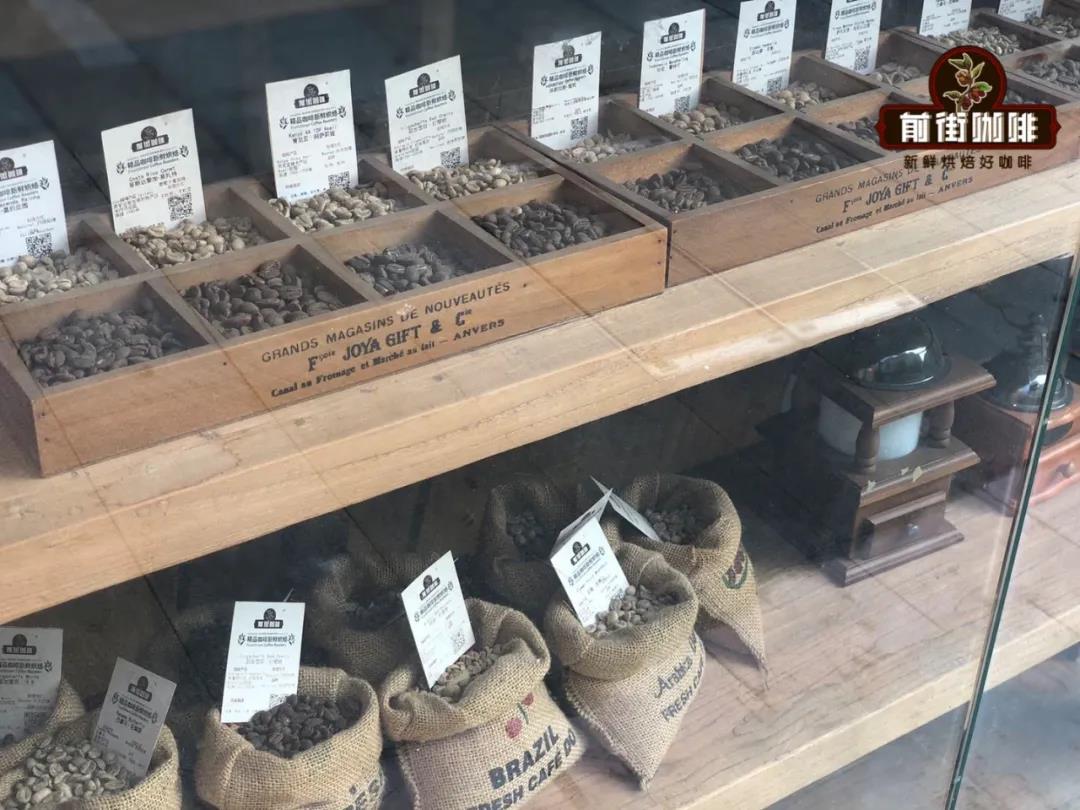How about African coffee?| Is coffee cheap in Africa and where can I buy it?

Professional coffee knowledge exchange more coffee bean information please follow the coffee workshop (Wechat official account cafe_style)
Distribution of coffee producing areas in Africa
The world's first coffee tree was found in the Horn of Africa. Local tribes often grind the fruit of coffee and knead it with animal fat to make many ball-shaped balls. These indigenous tribes regard these coffee balls as precious food for those soldiers who are about to go out to battle.
At that time, people did not understand what it was all about when coffee eaters showed hyperactivity-they did not know that it was caused by the irritation of coffee. Instead, people regarded it as a religious fanaticism shown by coffee eaters. I think this drink is so mysterious that it has become a special product for priests and doctors.
Coffee is the main cash crop in Angola, the primary export of Burundi and the largest foreign exchange earning industry in Kenya in the past. Ethiopia is known as the "hometown of coffee"; C ô te d'Ivoire occupies an important position in the world in coffee production; Uganda is famous for its production per unit area in Africa.
As the birthplace of coffee, Africa is a land full of game beans, and the continent deserves to produce some of the world's top coffee. African beans have a unique aroma, wild taste, mostly with a touch of sour red wine, such as Ethiopia's "mocha" is particularly wonderful (Hara and Tijima two producing areas with dry treatment of high-quality mocha beans, such as fruit or wine aromas, is inferior to other coffee), Yekashev coffee beans are also very good. Kenyan varieties are delicious, showing more bright and lively acidity than Arabica coffee beans in other regions. Kenya AA is a very famous top coffee bean.
Republika (Rwanda) (Rwanda)
Rwanda is a country in east-central Africa, the full name of the Republic of Rwanda, located in the south of the equator in east-central Africa, landlocked countries. It is bordered by Tanzania to the east, Burundi to the south, the Democratic Republic of the Congo to the west and northwest, and Uganda to the north, with a land area of 26338 square kilometers. Most areas belong to tropical plateau climate and savanna climate, mild and cool, with an annual average temperature of 18 ℃.
The whole year is divided into two dry seasons and two rainy seasons, with a heavy rainy season from March to May and a light rainy season from October to December, with an average annual precipitation of 1000mm to 1400mm. The area is 26338 square kilometers. There are many mountainous plateaus in Rwanda, with more than 1800 large and small mountains, known as "the country of a thousand hills". There are many hills, swamps and lakes in the east, with dense water networks and vast natural pastures, while the central part is the lowland along the lake.
The northwest is a mountain made up of a group of volcanoes. Rwanda is closest to the equator, but drowns more than 1500 meters above sea level, and the annual average temperature is only 18% C. coupled with abundant rainfall, suitable hydrothermal conditions and picturesque scenery, it is known as "the land of everspring" and "Africa Switzerland".
It was reduced to a "German East African protectorate" in 1890. It was appointed by Belgium after World War I. It was changed to Belgium's "trusteeship" after World War II. In the 1930s, coffee became a necessary crop for producers.
The Belgian government strictly controlled export and imposed high taxes on coffee farmers, forcing Rwanda to move towards high-yield and low-quality coffee production. On July 1, 1962, it declared independence and established a republic. On July 5, 1973, the second Republic was established. In the 1990s, coffee became the most valuable agricultural product for export in Rwanda. The civil war broke out again after Hutu President Habyarimana was killed in a plane crash on April 6, 1994, resulting in a massacre in which nearly one million people were killed. Coupled with the sharp drop in global coffee prices, it has had a huge impact on the coffee industry.
After the genocide coffee production has had a positive impact on the overall recovery of Rwanda. With the attention at home and foreign assistance, the coffee industry has received great attention. With new processing plants in the country, people began to focus on high-quality coffee production.
The first wet treatment plant in China was built in 2004, after which a large number of wet treatment plants began to appear, and now it has exceeded 300 degrees. The Rwanda Joint Partnership for Agricultural Promotion (PEARL) was established to successfully share knowledge and train young agronomists, which eventually evolved into a sustainable partnership for the development of rural enterprises.
Ethiopia (Ethiopia)
Ethiopia is one of the major producers of Arabica coffee in Africa, producing the best Arabian coffee in the world. It is said that coffee was first discovered by shepherds in Essekafa, and the name of coffee evolved from Kafa, which is well-deserved as the "hometown of coffee".
The geographical environment of Ethiopia is very suitable for coffee growth. Coffee is mainly grown in the southern highlands between 1100 and 2300 meters above sea level. The soil in these areas is well drained, slightly acidic and red loose. Currently, about 25% of the Ethiopian population depends directly or indirectly on coffee production for a living. The majority of farmers use traditional planting methods. Artificial care of coffee trees, the use of organic fertilizers, do not use harmful pesticides and herbicides, etc. Therefore, most of the coffee produced in Ethiopia is organic coffee.
The natural characteristics of coffee beans include size, shape, acidity, texture, taste and aroma. Ethiopian coffee beans are small, fragrant and sour like wine, and are loved by coffee lovers. Because of its unique aroma and taste, it is often used in the production and variety improvement of beverages, ice cream and sweets.
Due to different planting methods, coffee can be divided into three types: forest-semi-forest coffee (Forest or semi-forest coffee), courtyard coffee (Garden coffee) and plantation coffee (Plantation coffee). 60% of the coffee belongs to forest-semi-forest coffee. In such a wild coffee forest, pesticides are not used at all, but biological methods are used to control pests. 35% of the coffee is courtyard coffee. In this kind of coffee garden, the planting is three-dimensional. Coffee is located in the lower layer and gets a suitable growth environment in the shade of other crops. Fertilizers are mainly fallen leaves, withered grass and animal manure. 5% of the coffee belongs to plantation coffee. This is a modern species.
In the way of planting, coffee is also grown in the forest, but new varieties are used and planted in rows with other shade trees. Due to different processing methods, coffee can be divided into washed coffee (Washed coffee) and sun-cured coffee (Sun-dried coffee). Washed coffee accounts for 35% of exports. Good quality washed coffee is processed with freshly picked fully ripe fruit, picked carefully and closely monitored by professionals.
The picked clean coffee beans are pulped on the day of picking, then fermented, washed, dried and peeled. The humidity of processed coffee beans is kept at about 12%. Sun-cured coffee accounts for 65% of exports. Mainly picked by families, red coffee beans are placed on cement floors or on high tables to dry to about 11.5% humidity, then peeled and cleaned.
The world-famous Ethiopian coffee is mainly: 1. Limu coffee grows between 1400 meters and 2000 meters above sea level. Wash the coffee. Excellent quality, with strong nut aromas, suitable acidity, with the intensity of wine. The annual output is 29000 tons. 2. Jima Coffee grows between 1400 and 1800 meters above sea level. Sun-baked coffee. Slightly sour, with nutty aromas and a long finish. The annual output is 70000 tons. 3. Gambi coffee grows between 1500 meters and 2300 meters above sea level. It is gourmet coffee with moderate acidity and fruity aroma. The annual output is 34000 tons. 4. Yerqin coffee grows from 1500 meters to 2200 meters above sea level. Mocha flavor, with floral and spicy aromas. The average annual output is about 28000 tons. 5. Sidamo Coffee grows at an altitude of 1400-2200 meters. Suitable acidity and high quality. The average annual output is about 37000 tons. 6. Harald Coffee grows on highlands above 2700 meters above sea level. It is the best coffee in the world, medium acidity, intoxicating exotic flavor, with slightly tipsy, dried fruit aroma, is pure mocha coffee. The average annual output is about 26000 tons.
Kenya (kenya)
Kenya's upland washed Arabica beans are one of the best coffee in the world in terms of quality. The coffee industry in Kenya is of good quality and consistent under the strict control of the Kenya Coffee Agency. Kenyan coffee is famous for its strong fruit flavor, with lemon and citrus acid aromas.
Kenya is bordered to the north by Ethiopia, the origin of Arabica coffee trees, but it was not until the beginning of the 20th century that coffee cultivation began. In the 19th century, missionaries introduced Arabica trees from Yemen, but did not plant them in large quantities. It was not until 1893 that coffee was cultivated on a large scale after the introduction of Brazil's ancient bourbon seeds. That is to say, Kenyan coffee is of Brazilian origin. Due to the differences in water, climate and handling, the taste of Kenyan beans is very different from that of Brazilian beans.
Kenyan coffee trees are mainly concentrated on the slopes near Mount Kenya, about 4 to 6500 feet above sea level, which is the best height for coffee beans to develop their flavor, because the mountain temperature is lower, the growth is slower, and the aromatic components of coffee beans are fully developed. the acidity is more obvious and the texture is harder. In addition, Kenya was an early British colony, and the British had established a set of perfect cultivation and quality control system. After the independence of Kenya, the coffee industry has made great strides on the existing basis, and has become the largest foreign exchange earning industry in Kenya.
Kenya beans must have a strict grading system. Coffee beans taken out by washing plants are divided into seven grades according to size, shape and hardness, the highest being AA or AA, followed by AB, PB, C, TT and T. This grading system is similar to Colombia, mainly in terms of particle size and shape, but it does not necessarily have the best flavor.
Tanzania (Tanzania)
Tanzania is a typical East African country, bordering Kenya and Uganda to the north, Malawi, Mozambique and Zambia to the south, and Rwanda and Burundi to the west. Many people like to compare Tanzanian coffee with his neighbor Kenya. Compared with Kenyan high-quality coffee beans, Tanzanian coffee has less bright acidity, softer beauty and more sweetness. The strong smell of red wine is also a characteristic of Tanzania.
Coffee beans in Tanzania are of extraordinary quality. They are produced in the Mohi district near Mount Kilimanjaro. The mountains with a height of 3,000 to 6,000 feet are the most suitable areas for growing coffee. The fertile volcanic ash gives the coffee here a strong texture and soft acidity. It exudes delicate aromas and contains aromas of wine and fruit, making people taste endless aftertaste.
After drinking Tanzanian coffee, I always feel a soft and mellow earthy smell at the corners of my mouth. Coffee gourmets often use words such as "wild" or "wild" to describe it. It can be said that pure Tanzanian coffee is "the most African coffee". Tanzania AA is the highest grade of beans, its grains are full, pure flavor, rich and refreshing, all aspects of quality are good. Usually it is mildly acidic and evenly stimulates the taste buds in the middle and sides of the back of the tongue, feeling a bit like the sour taste of tomato or soda.
After moderate or more moderate baking, it has a strong aroma, then grind it into a fine powder, soak it in a pot of boiling water, invite friends to sit around and taste it, and suddenly feel fragrant and full of tongue. its quality is much better than the instant coffee we often drink. Tanzanian coffee has long been loved by Europeans and has joined the ranks of famous products. Europeans give Tanzanian coffee the nickname "coffee gentleman".
END
Important Notice :
前街咖啡 FrontStreet Coffee has moved to new addredd:
FrontStreet Coffee Address: 315,Donghua East Road,GuangZhou
Tel:020 38364473
- Prev

The difference between the steps of anaerobic solarization and anaerobic washing process for the treatment of coffee beans
For more information on coffee beans, please follow the coffee workshop (official Wechat account cafe_style). Anaerobic solarization (Anaerobic) fermentation is a very popular post-processing method in recent years. Coffee fruit is usually placed in an airtight container or in a washing tank.
- Next

Which country in Africa has the best coffee? how to drink the coffee brought back by Africa?
Professional coffee knowledge exchange more coffee bean information please follow the coffee workshop (Wechat official account cafe_style) Ethiopia global market share: 5% treatment: washing and tanning season: October-December output (2012): 8 million bags main varieties: Arabica, Ethiopia original varieties global production ranking: Ethiopia, the world's fifth largest coffee producer
Related
- Beginners will see the "Coffee pull flower" guide!
- What is the difference between ice blog purified milk and ordinary milk coffee?
- Why is the Philippines the largest producer of crops in Liberia?
- For coffee extraction, should the fine powder be retained?
- How does extracted espresso fill pressed powder? How much strength does it take to press the powder?
- How to make jasmine cold extract coffee? Is the jasmine + latte good?
- Will this little toy really make the coffee taste better? How does Lily Drip affect coffee extraction?
- Will the action of slapping the filter cup also affect coffee extraction?
- What's the difference between powder-to-water ratio and powder-to-liquid ratio?
- What is the Ethiopian local species? What does it have to do with Heirloom native species?

